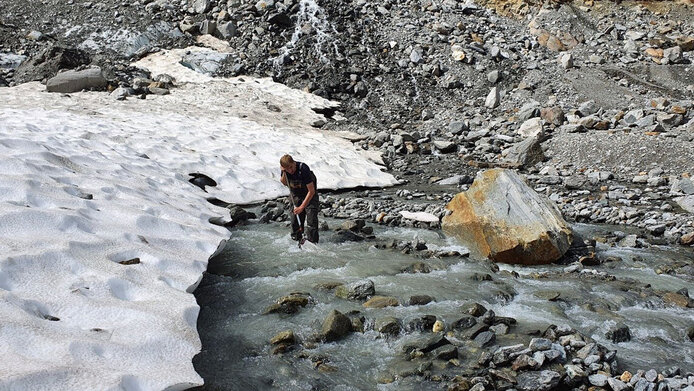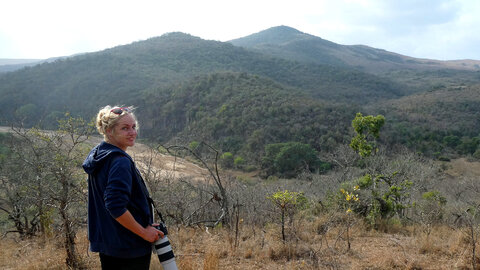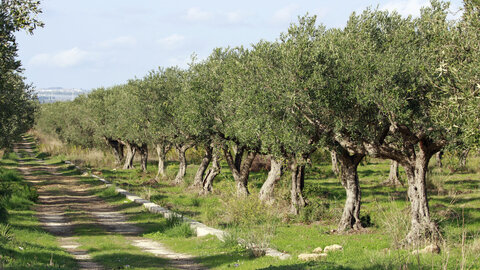Midges furnish insights into the glacier’s ecosystem

The environment gets uncomfortable at 2,000 meters above sea level. On top of the cold, extreme weather events, a shortage of nutrients and brief growing seasons keep the majority of living creatures away from the high mountain regions. Reinhard Lackner from the University of Innsbruck puts things into perspective: “From a human viewpoint, this is an extreme habitat. But you can't look at everything from our angle.” This zoologist has been researching life in Austria's glacial streams for decades and knows that what may look lifeless often is not. “At first glance, these areas appear very sterile. And yet, surprisingly, some creatures can survive despite these extreme conditions,” notes Lackner.
One of the species that have adapted to the harsh conditions are chironomids (also called nonbiting midges or lake flies). Their larvae colonize the entire course of glacial streams and, in some places, account for 100 percent of the fauna present. In a project funded by the Austrian Science Fund FWF, Lackner's team is investigating the life cycle of chironomids to learn how they survive in these regions, hoping it will give them insights into climatic changes. After all, as the glaciers are disappearing, so are the midges’ larvae.
Retreat into cold waters
There are thousands of species of chironomids worldwide; in Europe alone, their number is in the hundreds. Depending on the species, they lay their eggs in fresh or salt water, from thermal springs to the Antarctic. “The different midge species colonize specific habitats. Even the slightest changes in the habitat have an impact on which species are present,” explains Lackner. For this reason, chironomids are also used to determine water quality: depending on the nutrient content of the water, a different spectrum of species will inhabit it.
Only around a dozen species manage to survive in the highest part of a glacial stream – right where it leaves the glacier. Lackner suspects that they do not really choose to live in this extreme habitat, but perhaps retreat there to escape predators in the warmer waters below. Lacker postulates that the animals are now forced to migrate further and further upstream due to global warming and rising water temperatures. Additionally, toxic substances are released when the surrounding permafrost thaws, which can also harm the larvae. “This means that the extreme location is turning into a kind of refuge for these species. We are interested in the factors that influence the distribution and survival of the midges,” says Lackner. In his research project, he is investigating the boundaries of larvae occurrence. On the basis of his findings he is also tracing the history of European glaciers.
Glacier melt past and present
One of these findings concerning the glacier melt at the end of the last ice age was established by the team investigating fossil finds of chironomid larvae from the Bohemian Forest. This mountain range on the German-Czech-Austrian border was covered by glacial ice until around 12,000 years ago. The spectrum of fossil midge species in the sediment of lakes there now shows that glacial streams once fed such lakes. Finds from different eras also enable the researchers to assess how climatic changes influenced the occurrence of chironomids.
Similar processes are also important today. At the moment, glacial mass is constantly decreasing, which impinges upon the sensitive ecosystems of the high mountains. In order to investigate these processes, Lackner's team is fishing for chironomid larvae in the meltwater stream of the Rotmoosferner glacier near Obergurgl in Tyrol. The researchers use this glacial stream as a model system to help them better understand the special ecosystem of the high mountain region. Their findings are then compared with results from the High Tatras (Polish-Slovakian border) and the Pyrenees (French-Spanish border).
A decline in these highly specialized midges could trigger far-reaching changes. Living on diatoms in the water and on the material that is released when glaciers melt, chironomid larvae form the basis of the food chain. “Without them, there would be no fish in the streams, for instance,” notes Lackner. This is why his research project hinges particularly on the question of how the midges’ extraordinary adaptability can be explained.
Examination methods prove to be bottleneck
Since they are just a few millimeters wide and partly weigh just 0.1 milligrams, the larvae confront the team with a particular challenge. On the one hand, this limits the amount of sample material for investigations, and, on the other, the countless species are difficult to distinguish under the microscope.
In the context of the project, the research group and their collaboration partners from the Czech Republic succeeded in publishing details of significant progress as to the investigation methods. Their advances related to species identification by means of genetic analyses, and they were able to set up an experimental protocol that enables them to determine the energy status of single larvae at an individual level. “This was prompted by the consideration that animals that are starving or sick have fewer reserves in the form of fat and carbohydrates,” explains Lackner. “In this way, the nutritional status of the animals can be harnessed to track surrounding environmental conditions over several months.”
The measured fat and carbohydrate values confirmed that the animals' energy balance is kept at a minimum level. “This indicates their high adaptability. The most important factor in extreme habitats is the ability to survive long periods of unfavorable conditions,” Lackner comments on his findings.
Long-term monitoring in Obergurgl and beyond
The study of the chironomid population on the Rotmoosferner glacier is anchored in a long-term research project. Since the foundation of the local research station back in 1951, researchers have been conducting interdisciplinary research, collecting data on the retreat of the glacier and the ongoing colonization of the glacier forefield by plants and animals. The project seeks to gain a comprehensive understanding of the special ecosystem of high mountain regions. “We know that there are only a few areas on Earth where there is no life. By conducting research in this extreme region, I am exploring the question of the challenges living beings can surmount,” concludes Lackner. For the midges, the boundaries are located high, way up high.
Personal details
Reinhard Lackner, a zoologist at the University of Innsbruck, conducts research into life in high mountain waters – from chironomid larvae to river trout. His investigations seek to explore which factors influence the extreme ecosystem and how much alteration has already been brought about by climate change. The project “Life at the Edge: The Limits of Occurrence of Insect Larvae”, which was completed at the beginning of 2024, received roughly EUR 320,000 in funding from the Austrian Science Fund FWF.
Publications
Dvorak M., Dittmann I.L., Pedrini-Martha V. et al.: Molecular and morphological characterisation of larvae of the genus Diamesa Meigen, 1835 (Diptera: Chironomidae) in Alpine streams (Ötztal Alps, Austria), in: PLOS ONE 2024
Dvorak M., Dittmann I.L., Pedrini-Martha V. et al.: Energy status of chironomid larvae (Diptera: Chironomidae) from high alpine rivers (Tyrol, Austria), in: Comparative Biochemistry and Physiology A: Molecular & Integrative Physiology 2023





